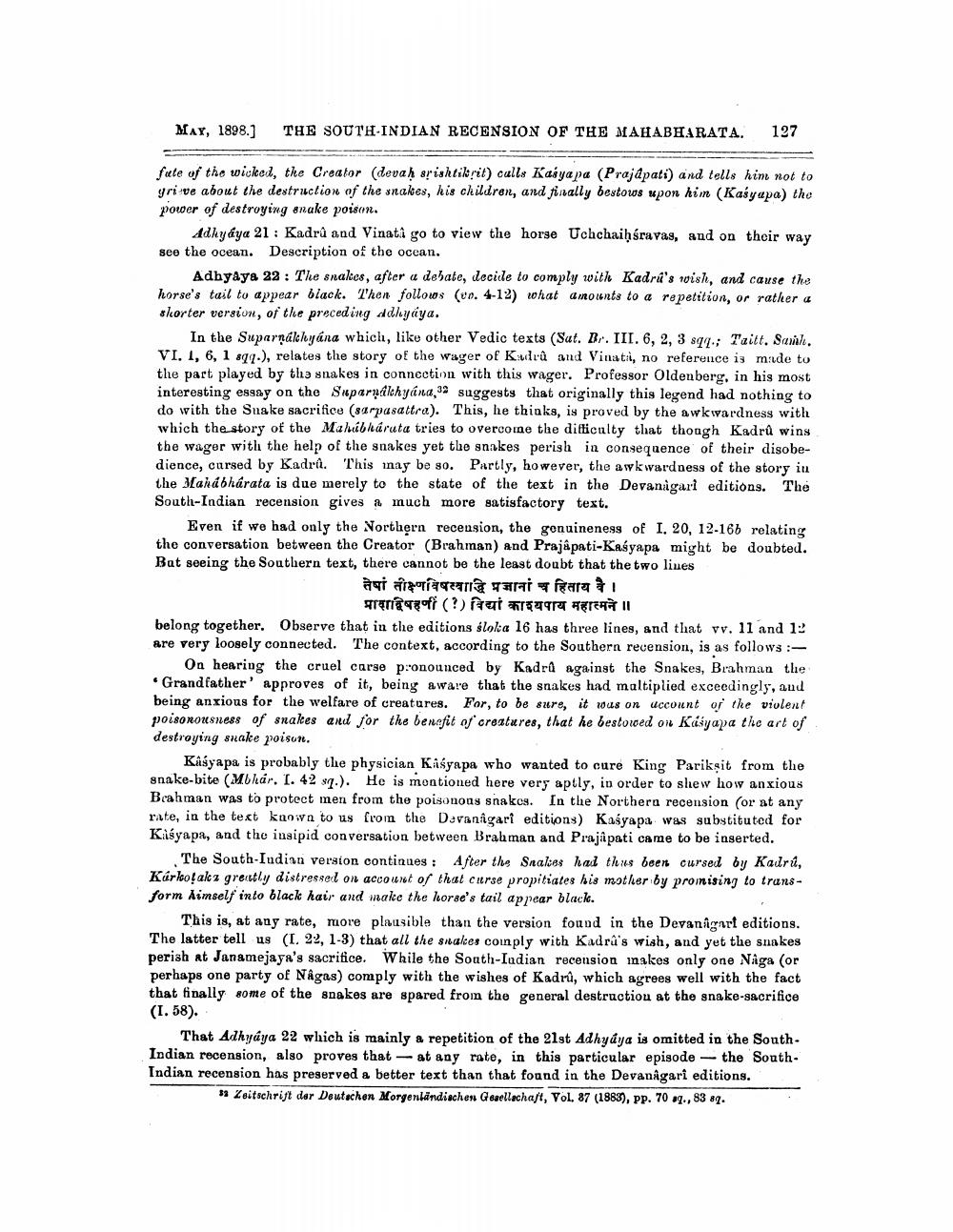________________
MAY, 1898.)
THE SOUTH INDIAN RECENSION OF THE MAHABHARATA.
127
fute of the wicked, the Creator (devaḥ srishtikrit) calls Kasyapa (Prajapati) and tells him not to yri ve about the destruction of the snakes, his children, and finally bestows upon him (Kasyapa) the power of destroying enake poison.
Adkyáya 21 : Kadrů and Vinati go to view the horse Uchchaiḥśravas, and on their way see the ocean. Description of the ocean.
Adhyâya 22: The snakes, after a debate, decide to comply with Kadri's wish, and cause the horse's tail to appear black. Then follows (vo. 4-12) what amounts to a repetition, or rather a shorter version, of the preceding ddhyaya.
In the Suparnáklyána which, like other Vedic texts (Sat. Br. III. 6, 2, 3 891.; Taitt. Sank. VI. 1, 6, 1 899.), relates the story of the wager of Kurû and Vinati, no reference is m:ide to the part played by the snakes in connection with this wager. Professor Oldenberg, in his most interesting essay on the Suparnalthyána, 3a suggests that originally this legend had nothing to do with the Snake sacrifice (sarpasattre). This, he thinks, is proved by the awkwardness with which the story of the Mahubháruta tries to overcome the difficulty that though Kadrû wins the wager with the help of the snakes yet the snakes perish in consequence of their disobedience, cursed by Kadra. This inay be so. Partly, however, the awkwardness of the story in the Mahabharata is due merely to the state of the text in the Devanagari editions. The South-Indian recension gives a much more satisfactory text.
Even if we had only the Northern recension, the genuineness of I. 20, 12-166 relating the conversation between the Creator (Brahman) and Prajapati-Kaśyapa might be doubted. Bat seeing the Southern text, there cannot be the least doubt that the two lines
तेषां तीक्ष्णविषस्वाद्धि प्रजानां च हिताय वै ।
grenieroff (?) fegireurT HETER II belong together. Observe that in the editions sloka 16 has three lines, and that vv. 11 and 12 are very loosely connected. The context, according to the Southern recension, is as follows:
On hearing the cruel carse pronounced by Kadrû against the Snakes, Brahman the Grandfather' approves of it, being aware that the snakes had maltiplied exceedingly, and being anxious for the welfare of creatures. For, to be sure, it was on account of the violent poisonousness of snakes and for the benefit of creatures, that he bestored on Kosyapa the art of destroying snake poisunt.
Kasyapa is probably the physician Kisyapa who wanted to cure King Parikşit from the snake bite (Mohár. I. 42 sq.). He is montioned here very aptly, in order to slew how anxious Brahman was to protect men from the poisonous snakes. In the Northern recension (or at any rate, in the text known to us from the Devanagari editions) Kaśyapa was substituted for Kiśyapa, and the insipid conversation between Brahman and Prajâ pati came to be inserted.
The South-Indian version continues : After the Snakes had thus beert cursed by Kadrú, Kárkoļak z greatly distressed on account of that curse propitiates his mother by promising to transform Aimself into black hair and make the horse's tail appear black.
This is, at any rate, more plausible than the version found in the Devanagart editions. The latter tell us (1. 22, 1-3) that all the snakes coinply with Kadri's wish, and yet the snakes perish at Janamejaya's sacrifice. While the South-Indian recension nakes only one Någa (or perhaps one party of Någas) comply with the wishes of Kadrů, which agrees well with the fact that finally some of the snakes are spared from the general destruction at the snake-sacrifice (1.58).
That Adhyâya 22 which is mainly a repetition of the 21st Adhyâya is omitted in the South Indian recension, also proves that at any rate, in this particular episode the SouthIndian recension has preserved a better text than that found in the Devanagari editions.
» Zeitschrift der Deutschen Morgenländischen Gesellschaft, Vol. 87 (1883), pp. 70., 83 89.




